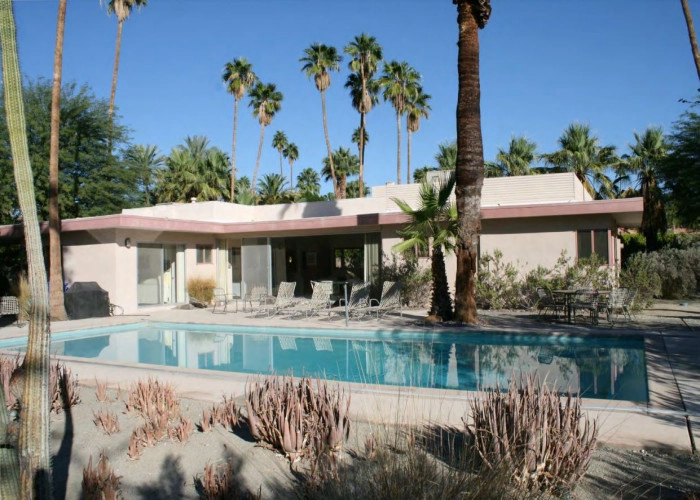Share what you know,
and discover more.
Share what you know,
and discover more.
Sep 28, 2015

-

- Dave D
National Register of Historic Places
From the National Register of Historic Places Registration Form Summary: The Sieroty House of 1941 is located in the Movie Colony district of Palm Springs. This single-family dwelling was one of the earliest residential commissions Albert Frey received after settling permanently in the desert a few years earlier. It appeared the same year as his own dwelling, Frey House I. While both houses feature a flat roof and large sliding glass doors, the Sieroty House differs in its wood frame construction and stucco finish. In addition, the Sieroty property is punctuated with numerous steel frame fixed and casement windows. Since its original construction, the Sieroty family—who continue to own the residence—retained Frey to design an addition to the living room and sliding glass doors for a bedroom. The house is in excellent condition and exhibits a high level of integrity. Narrative: Designed early in Frey’s Palm Springs career, the Sieroty House is finished in stucco versus the corrugated metal and asbestos board that clads his later residential work. The dwelling’s flat roof, deep overhangs, pipe post supports, open carport, large expanses of fixed glazing, and sliding glass doors are elements that appeared throughout his architectural career. The one-story house is L-shaped in plan, and located in one of the city’s oldest residential neighborhoods known as the Movie Colony due to the presence of numerous Hollywood luminaries who resided there prior to World War II. The large parcel upon which the dwelling sits is landscaped primarily with coarse gravel and desert plants with tall hedges and palm trees surrounding the perimeter. As noted, steel-framed fixed and casement windows punctuate the stucco-finished house on all elevations including most corners. The rear (south) elevation facing the swimming pool is entirely glazed with an enormous floor-to-ceiling fixed window adjacent to sliding glass doors. The projecting bedroom also contains pool-facing sliding glass doors. Inside the house, the living room fireplace is framed by glazed tiles that together display a short poem written by owner Julian Sieroty and dated 1941, the year of the home’s construction. Two small bedrooms are located at the east end of the house with the kitchen and dining room on the west end. The varnished wood front door features a porthole window. Extending from the west elevation is the single-vehicle carport with its flat roof supported by steel posts. Building permits document the introduction of a swimming pool at the rear of the house in 1951 and, in 1957, the installation of pool-facing sliding glass doors to the southwest bedroom. The addition of air conditioning in 1965 resulted in the erection of a tall, recessed metal screen on the roof to conceal the equipment and ductwork. Of these modifications, only the metal screen on the roof is visible from the public right-of-way. While detracting from Frey’s original flat roof design, the screen—which is easily removable—does not materially affect the integrity of design, materials, or workmanship given the unmodified nature of the remainder of the house. As a result, the Sieroty House is able to convey its architectural significance because the property retains the essential physical features associated with the early work of Albert Frey. These features include a flat roof, deep overhangs, stucco finish, steel-framed casement windows, large expanses of glass, and slender steel posts. In addition, the design rejects applied ornamentation and historical references. The Sieroty House retains the integrity of association as it continues to be owned by the Sieroty family and used as a single-family residence. The dwelling is at its original location and the setting has been retained. Because of these factors, the integrity of feeling also remains high.
National Register of Historic Places
From the National Register of Historic Places Registration Form Summary: The Sieroty House of 1941 is located in the Movie Colony district of Palm Springs. This single-family dwelling was one of the earliest residential commissions Albert Frey received after settling permanently in the desert a few years earlier. It appeared the same year as his own dwelling, Frey House I. While both houses feature a flat roof and large sliding glass doors, the Sieroty House differs in its wood frame construction and stucco finish. In addition, the Sieroty property is punctuated with numerous steel frame fixed and casement windows. Since its original construction, the Sieroty family—who continue to own the residence—retained Frey to design an addition to the living room and sliding glass doors for a bedroom. The house is in excellent condition and exhibits a high level of integrity. Narrative: Designed early in Frey’s Palm Springs career, the Sieroty House is finished in stucco versus the corrugated metal and asbestos board that clads his later residential work. The dwelling’s flat roof, deep overhangs, pipe post supports, open carport, large expanses of fixed glazing, and sliding glass doors are elements that appeared throughout his architectural career. The one-story house is L-shaped in plan, and located in one of the city’s oldest residential neighborhoods known as the Movie Colony due to the presence of numerous Hollywood luminaries who resided there prior to World War II. The large parcel upon which the dwelling sits is landscaped primarily with coarse gravel and desert plants with tall hedges and palm trees surrounding the perimeter. As noted, steel-framed fixed and casement windows punctuate the stucco-finished house on all elevations including most corners. The rear (south) elevation facing the swimming pool is entirely glazed with an enormous floor-to-ceiling fixed window adjacent to sliding glass doors. The projecting bedroom also contains pool-facing sliding glass doors. Inside the house, the living room fireplace is framed by glazed tiles that together display a short poem written by owner Julian Sieroty and dated 1941, the year of the home’s construction. Two small bedrooms are located at the east end of the house with the kitchen and dining room on the west end. The varnished wood front door features a porthole window. Extending from the west elevation is the single-vehicle carport with its flat roof supported by steel posts. Building permits document the introduction of a swimming pool at the rear of the house in 1951 and, in 1957, the installation of pool-facing sliding glass doors to the southwest bedroom. The addition of air conditioning in 1965 resulted in the erection of a tall, recessed metal screen on the roof to conceal the equipment and ductwork. Of these modifications, only the metal screen on the roof is visible from the public right-of-way. While detracting from Frey’s original flat roof design, the screen—which is easily removable—does not materially affect the integrity of design, materials, or workmanship given the unmodified nature of the remainder of the house. As a result, the Sieroty House is able to convey its architectural significance because the property retains the essential physical features associated with the early work of Albert Frey. These features include a flat roof, deep overhangs, stucco finish, steel-framed casement windows, large expanses of glass, and slender steel posts. In addition, the design rejects applied ornamentation and historical references. The Sieroty House retains the integrity of association as it continues to be owned by the Sieroty family and used as a single-family residence. The dwelling is at its original location and the setting has been retained. Because of these factors, the integrity of feeling also remains high.
Sep 28, 2015
National Register of Historic Places
From the National Register of Historic Places Registration FormSummary:
The Sieroty House of 1941 is located in the Movie Colony district of Palm Springs. This single-family dwelling was one of the earliest residential commissions Albert Frey received after settling permanently in the desert a few years earlier. It appeared the same year as his own dwelling, Frey House I. While both houses feature a flat roof and large sliding glass doors, the Sieroty House differs in its wood frame construction and stucco finish. In addition, the Sieroty property is punctuated with numerous steel frame fixed and casement windows. Since its original construction, the Sieroty family—who continue to own the residence—retained Frey to design an addition to the living room and sliding glass doors for a bedroom. The house is in excellent condition and exhibits a high level of integrity.
Narrative:
Designed early in Frey’s Palm Springs career, the Sieroty House is finished in stucco versus the corrugated metal and asbestos board that clads his later residential work. The dwelling’s flat roof, deep overhangs, pipe post supports, open carport, large expanses of fixed glazing, and sliding glass doors are elements that appeared throughout his architectural career.
The one-story house is L-shaped in plan, and located in one of the city’s oldest residential neighborhoods known as the Movie Colony due to the presence of numerous Hollywood luminaries who resided there prior to World War II. The large parcel upon which the dwelling sits is landscaped primarily with coarse gravel and desert plants with tall hedges and palm trees surrounding the perimeter. As noted, steel-framed fixed and casement windows punctuate the stucco-finished house on all elevations including most corners. The rear (south) elevation facing the swimming pool is entirely glazed with an enormous floor-to-ceiling fixed window adjacent to sliding glass doors. The projecting bedroom also contains pool-facing sliding glass doors. Inside the house, the living room fireplace is framed by glazed tiles that together display a short poem written by owner Julian Sieroty and dated 1941, the year of the home’s construction. Two small bedrooms are located at the east end of the house with the kitchen and dining room on the west end. The varnished wood front door features a porthole window. Extending from the west elevation is the single-vehicle carport with its flat roof supported by steel posts.
Building permits document the introduction of a swimming pool at the rear of the house in 1951 and, in 1957, the installation of pool-facing sliding glass doors to the southwest bedroom. The addition of air conditioning in 1965 resulted in the erection of a tall, recessed metal screen on the roof to conceal the equipment and ductwork. Of these modifications, only the metal screen on the roof is visible from the public right-of-way. While detracting from Frey’s original flat roof design, the screen—which is easily removable—does not materially affect the integrity of design, materials, or workmanship given the unmodified nature of the remainder of the house. As a result, the Sieroty House is able to convey its architectural significance because the property retains the essential physical features associated with the early work of Albert Frey. These features include a flat roof, deep overhangs, stucco finish, steel-framed casement windows, large expanses of glass, and slender steel posts. In addition, the design rejects applied ornamentation and historical references. The Sieroty House retains the integrity of association as it continues to be owned by the Sieroty family and used as a single-family residence. The dwelling is at its original location and the setting has been retained. Because of these factors, the integrity of feeling also remains high.
Posted Date
Dec 31, 2021
Historical Record Date
Sep 28, 2015
Source Name
United States Department of the Interior - National Park Service
Delete Story
Are you sure you want to delete this story?


















